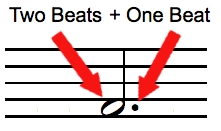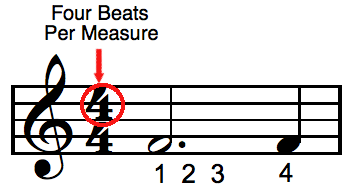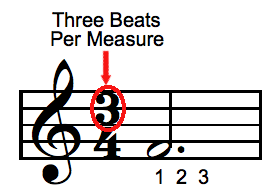A dotted half note is another music note symbol showing the length in which a musician should hold out a particular note. This note is similar to a half note, except the length it is held out is longer.
There are multiple aspects of this note that needs to be addressed. Its comparison to a normal half note, the length in which it should be held out, and how to use it in 4/4 time and 3/4 time.
Let’s take a look at how this note looks and how it compares to to half note.
Here It Is!

The dotted half note looks exactly the same as a half note. The only difference between these two is that the dotted note has a dot next to it. The dot is always going to be on the right side of the note.
This note is a circle or oval with a staff line going either up or down.

The dot that corresponds with the note will always sit inside one of the spaces on the staff.
Take a look at the image and see what a this note looks like. You can also see where the dot falls on the sheet music.
Note Length
The dot on any note tells us that you are to add half the value of the note.
We are looking at a half note, which is worth two beats. We then add on half of the value. Half of two is one, so we need to add one beat to the original two beats. This means that the dotted note is worth three beats.

Dotted Notes and Time Signature
It’s important to know the time signature you are playing in when using these notes.
The time signature is made up of two numbers, a top number and a bottom number. The top number tells you how many beats there are per measure.
4/4 Time

Look at the image, it tells us that there are four beats in the measure.
The dotted half note will only count for three of those four beats. There needs to be another note to take up the last beat.
In the image, it shows that there is three beats being taken up by the half note. The quarter note then takes up the fourth beat in the measure.
3/4 Time

This time signature is not used as much as 4/4 time, but it is still very common. In 3/4 time, the top number tells us that there are three notes per measure. Instead of four beats, there is now only three.
This changes things for the dotted half note. Above in 4/4 time, the dotted note didn’t take up the entire measure. In 3/4 time, the dotted note now takes up the entire measure.
There is no need for their to be any other notes, rests, or music note symbols.
The dotted note is used in 3/4 time like a whole note would be in 4/4 time.
Onward and Upward
Now that you understand what a dotted half note is and how it is used, its time to start using it in you music. The dot tells us to add half of what the note is worth. This makes this note worth three beats.
The most important thing you can do before you start to play a piece of music is look at the time signature. This is going to tell you how many beats there is going to be in a particular measure. Especially when using dotted half note, you need to be aware of this.
The dotted note will take up the entire measure in 3/4 time. It will only take up part of the measure in 4/4 time. There will need to be another music note symbol in the measure in 4/4 time.

